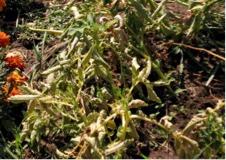Verticillium Wilt
-
AboutVerticillium Wilt, one of the most widespread and destructive soil-borne diseases of plants, attacks many woody and herbaceous species throughout the world. The causal fungus, verticillium dahliae, infects susceptible plants through the roots and invades and plugs the water conducting tissues. Verticlllium is especially damaging to tomatoes in California.
 Photo: Courtesy UC Regents
Photo: Courtesy UC Regents -
Category
-
Fungi
-
-
Signs/Symptoms
Early symptoms include yellowing of older leaves and wilting of shoot tips during the day. Later, leaf margins curl upward, and leaves often drop off. Diseased plants are stunted, and any fruit that is produced is usually small. When diseased plant stems are cut open with a knife and exposed, the water-conducting tissues usually appear streaked with a dark brown or black discoloration.
-
Where
Soil borne diseases.
-
When
Development of the fungus is favored by cool, moist spring weather, but wilting of foliage may not show up until sunny warm weather occurs and the plant is under stress.
-
Prevent
Do not plant Solanaceae family in contaminated bed for several years unless soil is removed and replaced. Rotate crops that are not susceptible to either wilt.
Planting verticillium-resistant varieties -- indicated by the letter "V" following the name -- is the most effective disease control measure.
-
Manage
There is no effective treatment for verticillium wilt. For affected vegetables, remove and dispose of the plant; don't compost it.
-
More Information

